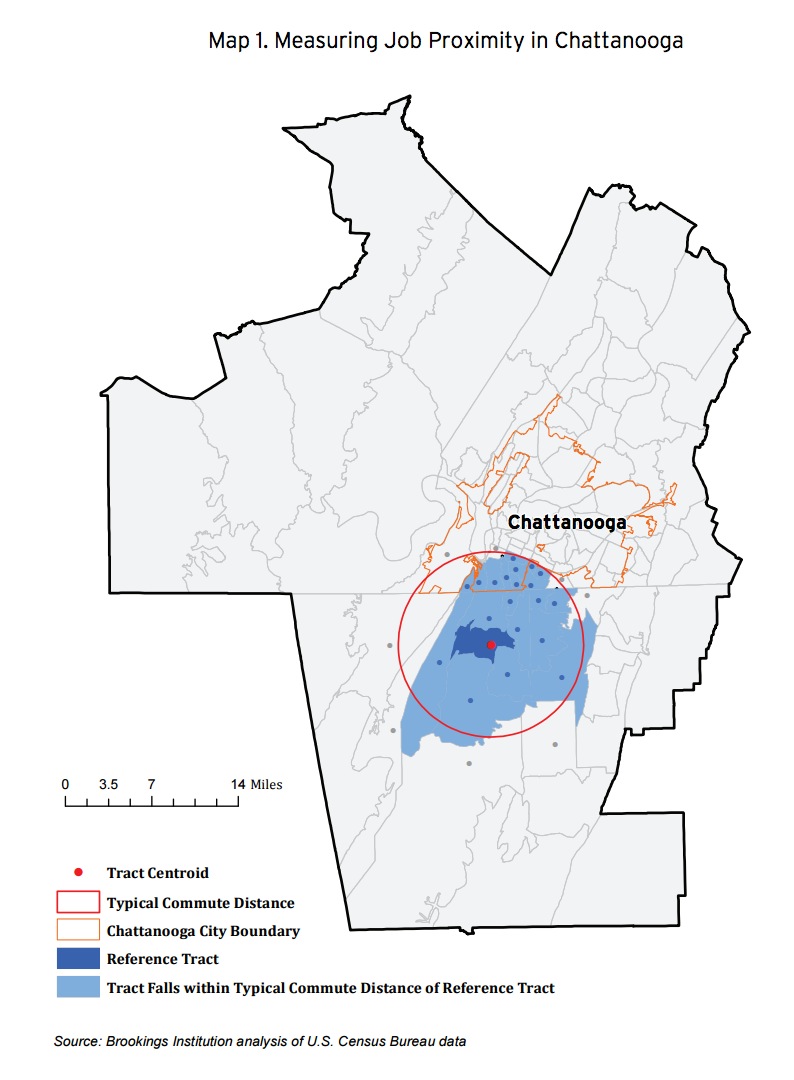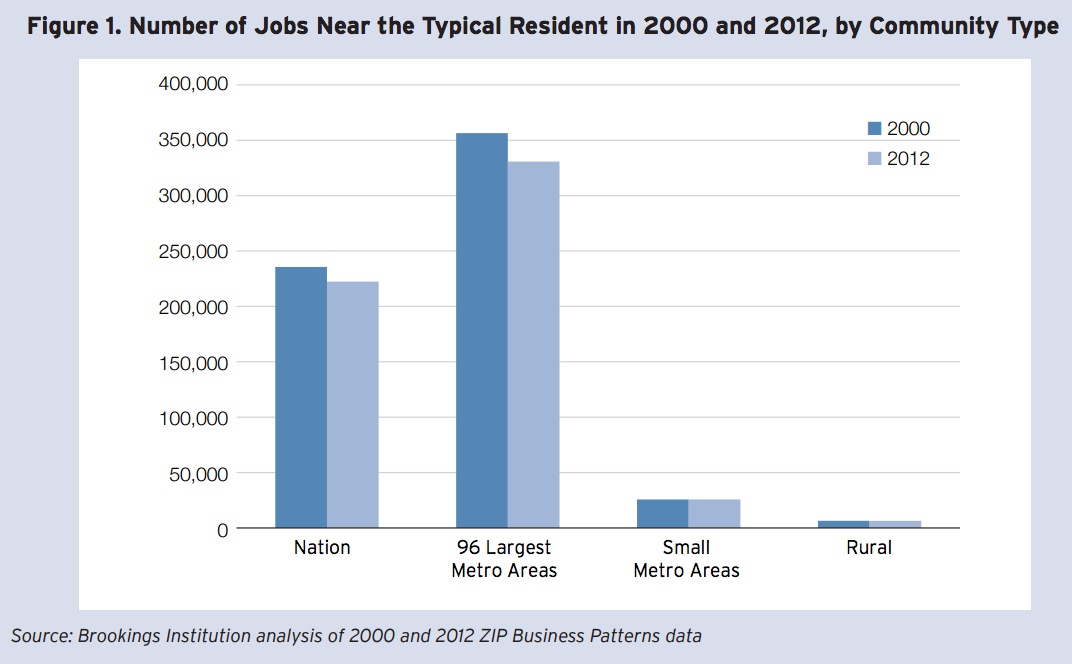BROOKINGS INSTITUTE
METROPOLITAN POLICY PROGRAM
Findings
Proximity to employment can influence a range of economic and social outcomes, from local fiscal health to the employment prospects of residents, particularly low-income and minority workers. An analysis of private-sector employment and demographic data at the census tract level reveals that:
- Between 2000 and 2012, the number of jobs within the typical commute distance for residents in a major metro area fell by 7 percent. Of the nation’s 96 largest metro areas, in only 29—many in the South and West, including McAllen, Texas, Bakersfield, Calif., Raleigh, N.C., and Baton Rouge, La.—did the number of jobs within a typical commute distance for the average resident increase. Each of these 29 metro areas also experienced net job gains between 2000 and 2012.
- As employment suburbanized, the number of jobs near both the typical city and suburban resident fell. Suburban residents saw the number of jobs within a typical commute distance drop by 7 percent, more than twice the decline experienced by the typical city resident (3 percent). In all, 32.7 million city residents lived in neighborhoods with declining proximity to jobs compared to 59.4 million suburban residents.
- As poor and minority residents shifted toward suburbs in the 2000s, their proximity to jobs fell more than for non-poor and white residents. The number of jobs near the typical Hispanic (-17 percent) and black (-14 percent) resident in major metro areas declined much more steeply than for white (-6 percent) residents, a pattern repeated for the typical poor (-17 percent) versus non-poor (-6 percent) resident.
- Residents of high-poverty and majority-minority neighborhoods experienced particularly pronounced declines in job proximity. Overall, 61 percent of high-poverty tracts (with poverty rates above 20 percent) and 55 percent of majority-minority neighborhoods experienced declines in job proximity between 2000 and 2012. A growing number of these tracts are in suburbs, where nearby jobs for the residents of these neighborhoods dropped at a much faster pace than for the typical suburban resident (17 and 16 percent, respectively, versus 7 percent).
For local and regional leaders working to grow their economies in ways that promote opportunity and upward mobility for all residents, these findings underscore the importance of understanding how regional economic and demographic trends intersect at the local level to shape access to employment opportunities, particularly for disadvantaged populations and neighborhoods. And they point to the need for more integrated and collaborative regional strategies around economic development, housing, transportation, and workforce decisions that take job proximity into account.
Introduction
 The 2000s ushered in significant demographic and economic changes that have redrawn the map of economic opportunity in metropolitan America.
The 2000s ushered in significant demographic and economic changes that have redrawn the map of economic opportunity in metropolitan America.
Two economic downturns and the weak recoveries that followed left the nation with fewer jobs in 2010 than in 2000. As jobs declined, they continued to push farther outward within the nation’s largest metro areas. Almost every major metro area saw jobs shift away from the urban core during the 2000s.
As jobs suburbanized, so did people. Minorities and the poor suburbanized at the fastest pace, such that, by 2010 in the nation’s largest metro areas, the majority of every major ethnic and racial group and the majority of the poor lived in suburbs for the first time.
Where people and jobs locate within metro areas over time affects how close they are to one another. The outward shift of both people and jobs in the 2000s changed their proximity to each other, and often not for the better.
This study takes a new approach to determine how many jobs people live near, or what we term job proximity, throughout the United States. Proximity can influence a range of outcomes, from the fiscal health of a community to employment opportunities for residents. Differences across people and places in job proximity, and trends over time, illustrate how economic and demographic shifts in the 2000s reshaped the map of economic opportunity for different communities and populations.
Past research on the relationship between where people work and live often focused on understanding how the suburbanization of wealth and jobs may have affected access to employment opportunities for poor and minority residents left behind in the central city. These studies of what has been referred to as spatial mismatch or job accessibility have employed a variety of measures, including dissimilarity indexes (which compare the degree to which population and jobs locate together within communities), correlations between race and commute times or distances, and differences in labor market outcomes across cities and suburbs.
But the suburbanization of minority and poor residents since 2000 requires both a broader framing of the question—one that recognizes that, while economic opportunity has shifted within regions, so too have traditionally disadvantaged populations—as well as a more geographically fine-grained understanding of how proximity to employment varies from neighborhood to neighborhood and for different types of residents within metropolitan areas.
To carry out this analysis, we constructed a database that pulls together multiple sources of demographic and employment data for every census tract—small areas of about 4,000 people on average —in the nation. With that information, we assess the number of jobs proximate to each neighborhood (i.e., census tract) in the country, and how that proximity changed between 2000 and 2012, the most recent year for which we have data. Within the nation’s largest metro areas, we pay particular attention to how patterns and trends vary for different types of residents (e.g., by race and ethnicity and by poverty status) and communities (e.g., high-poverty or majority-minority neighborhoods).
Download full version (PDF): The Growing Distance Between People and Jobs in Metropolitan America
About the Brookings Metropolitan Policy Program
www.brookings.edu/about/programs/metro
The Metropolitan Policy Program at Brookings is redefining the challenges facing metropolitan America and identifying assets and promoting innovative solutions to help communities grow in more productive, inclusive, and sustainable ways.
Tags: Brookings Institute, Commute, Metropolitan America, Metropolitan Policy Program, Suburbs







 RSS Feed
RSS Feed